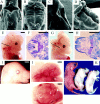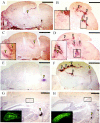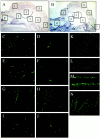Tumor necrosis factor receptor-associated factor 6 (TRAF6) deficiency results in exencephaly and is required for apoptosis within the developing CNS
- PMID: 11007897
- PMCID: PMC6772765
- DOI: 10.1523/JNEUROSCI.20-19-07384.2000
Tumor necrosis factor receptor-associated factor 6 (TRAF6) deficiency results in exencephaly and is required for apoptosis within the developing CNS
Abstract
Tumor necrosis factor receptor-associated factors (TRAFs) are adaptor proteins important in mediating intracellular signaling. We report here that targeted deletion of traf6 greatly increases the frequency of failure of neural tube closure and exencephaly in traf6 (-/-) mice. The penetrance of this defect is influenced by genetic background. Neural tube fusion requires the coordination of several biological processes, including cell migration invoked by contact-dependent signaling, cell proliferation, and programmed cell death (PCD). To gain greater insight into the role of TRAF6 in these processes, neural development and migration within the CNS of traf6 (-/-) mice and controls were assessed through temporal examination of a number of immunohistochemical markers. In addition, relative levels of cellular proliferation and PCD were examined throughout embryonic development using bromodeoxyuridine (BrdU) and in situ terminal deoxynucleotidyl transferase-mediated dUTP biotinylated nick end labeling (TUNEL), respectively. The data suggest that loss of TRAF6 does not significantly alter the level of cellular proliferation or the pattern of neural differentiation per se, but rather regulates the level of PCD within specific regions of the developing CNS. Substantial reductions in TUNEL were observed within the ventral diencephalon and mesencephalon in exencephalic traf6 (-/-) embryos. Our results demonstrate a novel and prominent role for TRAF6 in the regional control of PCD within the developing CNS.
Figures






References
-
- Arch RH, Gedrich RW, Thompson CB. Tumor necrosis factor receptor-associated factors (TRAFs): a family of adapter proteins that regulates life and death. Genes Dev. 1998;12:2821–2830. - PubMed
-
- Bertin J, Nir WJ, Fischer CM, Tayber OV, Errada PR, Grant JR, Keilty JJ, Gosselin ML, Robison KE, Wong GH, Glucksmann MA, DiStefano PS. Human CARD4 protein is a novel CED-4/Apaf-1 cell death family member that activates NF-kappa B. J Biol Chem. 1999;274:12955–12958. - PubMed
-
- Cao Z, Xiong J, Takeuchi M, Kurama T, Goeddel DV. TRAF6 is a signal transducer for interleukin-1. Nature. 1996;383:443–446. - PubMed
-
- Copp AJ, Brook FA, Estibeiro JP, Shum ASW, Cockroft DL. The embryonic development of mammalian neural tube defects. Prog Neurobiol. 1990;35:363–403. - PubMed
MeSH terms
Substances
LinkOut - more resources
Full Text Sources
Medical
Molecular Biology Databases
